Check out this video to learn more about the highly successful model David has infused into his planning process
In the realm of investment strategies, one of the more intriguing approaches is the endowment model, notably employed by large institutions like university endowments. This model, championed by figures like David Swensen of Yale University, offers unique insights for individual investors, especially those planning for retirement.
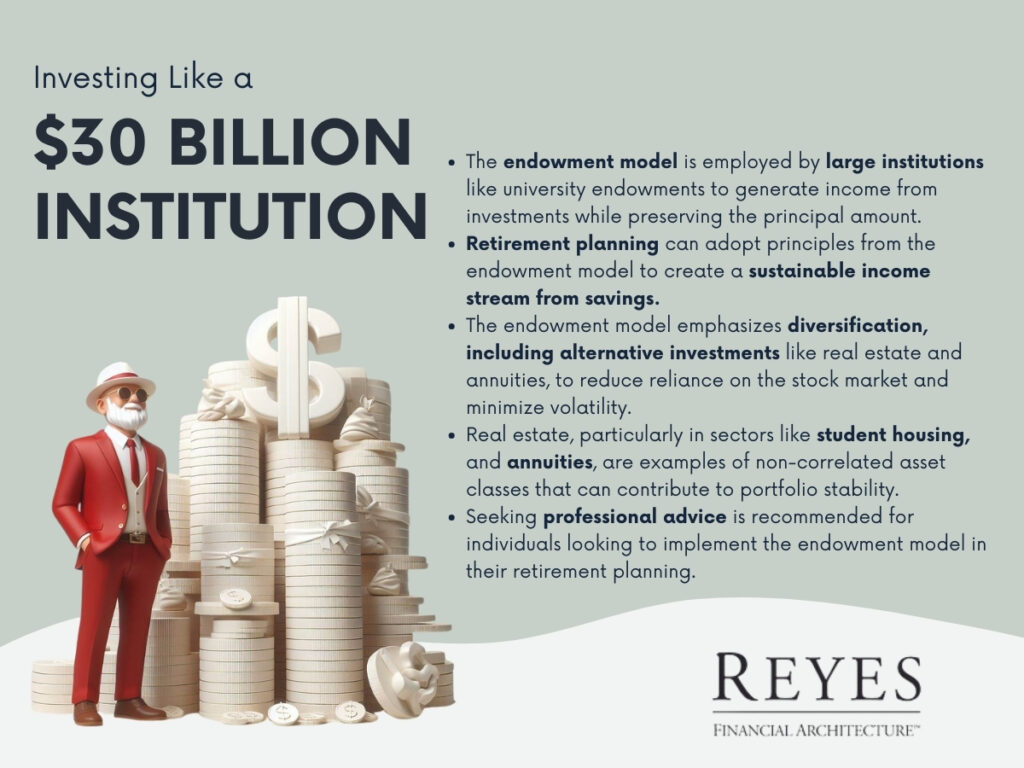
At its core, an endowment is a financial asset, like a fund, held by institutions such as universities. It’s made up of donations that are invested to generate income for the institution. The principal amount generally remains intact while the income supports various expenses.
The Yale endowment, under Swensen's management, became a hallmark of this approach. Yale’s strategy was not just successful but also revolutionary in how it diversified investments beyond the traditional stock and bond portfolio. This diversification aimed to achieve steady returns while minimizing risks.
Retirement planning can be akin to managing an endowment. In both cases, the goal is to create a sustainable income stream from a large pool of savings. The typical recommendation for endowment funds is to aim for a 5% annual distribution. This figure interestingly aligns with the retirement income strategies suggested by many financial planners.
However, a critical difference lies in the investment approach. Traditional retirement portfolios often focus heavily on stocks and bonds. In contrast, the endowment model advocates for a more diversified portfolio including alternative investments.
The endowment model’s success largely stems from its inclusion of alternative investments. These can range from private equity and hard assets like real estate to even more niche options like annuities. For instance, Yale’s portfolio in 2001 included a significant portion in hard assets, primarily real estate, alongside a smaller proportion in domestic and foreign equities.
This diversification strategy not only reduces reliance on the stock market but also potentially smoothens out returns, reducing volatility. The objective is to create a portfolio that can withstand market downturns better and provide more consistent returns over time.
Real estate, especially in sectors like student housing, is a prime example of an alternative investment that can offer stable returns. Properties near major universities, such as USC, Notre Dame, or Northwestern University, can provide a steady income stream, often with tax advantages.
Annuities are another diversifier in this model. While not directly linked to stock or bond markets, they can provide a steady income, adding another layer of stability to a retirement portfolio.
One of the key strengths of the endowment model is its use of non-correlated asset classes. Investments like real estate or annuities don’t necessarily move in tandem with the stock or bond markets. This non-correlation can significantly reduce the portfolio's overall risk.
For individual investors, adopting an endowment-like strategy means moving beyond the conventional wisdom of a stock-and-bond-dominated portfolio. It involves exploring and investing in a variety of asset classes. However, this approach requires careful planning and a thorough understanding of each investment type.
Given the complexity of this investment strategy, seeking professional advice is prudent. Financial advisors with experience in the endowment model can provide valuable insights and help tailor a portfolio that suits an individual’s retirement goals and risk tolerance.
The endowment model, inspired by the strategies of large institutions like Yale University, presents an innovative approach for individual investors, especially those in retirement planning.
Its focus on diversification across various asset classes aims to provide a balanced investment portfolio that can weather market volatility and generate sustainable income. While it may require stepping out of the traditional investment comfort zone, the potential for a more stable and robust retirement income is an enticing prospect for those willing to explore beyond stocks and bonds.
Check out this video to get some insight into David's personal story which lends to the purpose in his passion to help his clients achieve retirement success.
The world of retirement planning is deeply influenced by the personal experiences and histories of those who navigate it. One such journey, devoid of specific names but rich in lessons and insights, offers a valuable perspective on how early life experiences and family histories can shape professional philosophies in financial planning.

The story begins with a young individual, whose life was significantly impacted by their parents' divorce at the age of two. Raised by a single mother with two other children, this person found solace and guidance in the care of their grandparents. These formative years spent with grandparents in a small town provided foundational life lessons and values.
One grandparent, a dedicated employee at a major company like Sears Roebuck, which narrowly escaped bankruptcy, served as an emblem of resilience and adaptability. This grandparent's profession as a television repairman represented a now-obsolete trade, reflecting a bygone era of technological simplicity and hands-on skill.
The grandparent's investment in company stock, such as Sears, showcased the importance of financial involvement and awareness. This early exposure to stock investments and the significance of pension plans left a profound impact on the young individual, instilling a keen interest in financial planning and investment.
Despite modest means, the grandparent exemplified fiscal prudence and the virtue of saving, owning a home outright, and living within one's means. These characteristics were not just survival strategies but were also foundational principles that would later inform a career in financial planning.
A turning point in this narrative was the grandparent's diagnosis with dementia, leading to significant healthcare expenses that eventually depleted their savings. This transition to relying on Medicaid, a program necessitating minimal personal assets, highlighted the financial vulnerabilities faced in old age.
The family's subsequent struggle with a lien on their property due to Medicaid benefits underscored the complexities and challenges of elder care and its financial implications. This experience, occurring at the onset of the individual’s career in financial planning, was a catalyst for a deeper understanding of elder law and financial protection strategies.
These personal experiences with family financial challenges directly influenced the individual's approach to retirement planning. Observing first-hand the impact of medical expenses and the necessity of financial preparedness in later life, the individual adopted a philosophy emphasizing the protection of capital, its growth, and the generation of sustainable income from it.
This approach was further informed by the mindset of the "depression babies" generation, known for their skepticism towards banks and cautious approach to market investments. This background instilled a sensitivity towards clients who value security and stability in their financial planning.
This narrative, while not tied to a specific individual, illustrates how personal experiences can profoundly shape professional approaches in fields like financial planning. It's a poignant reminder that behind the technical aspects of financial advising are human stories, experiences, and histories that influence and guide the strategies and advice offered by professionals in this field.
Retirement planning is an essential aspect of financial management, yet it remains a challenging endeavor for many. Understanding the nuances of investment, market trends, and effective strategies is vital for a secure retirement.
This blog post explores key principles and strategies to help individuals build a robust retirement plan, emphasizing risk management and financial efficiency.
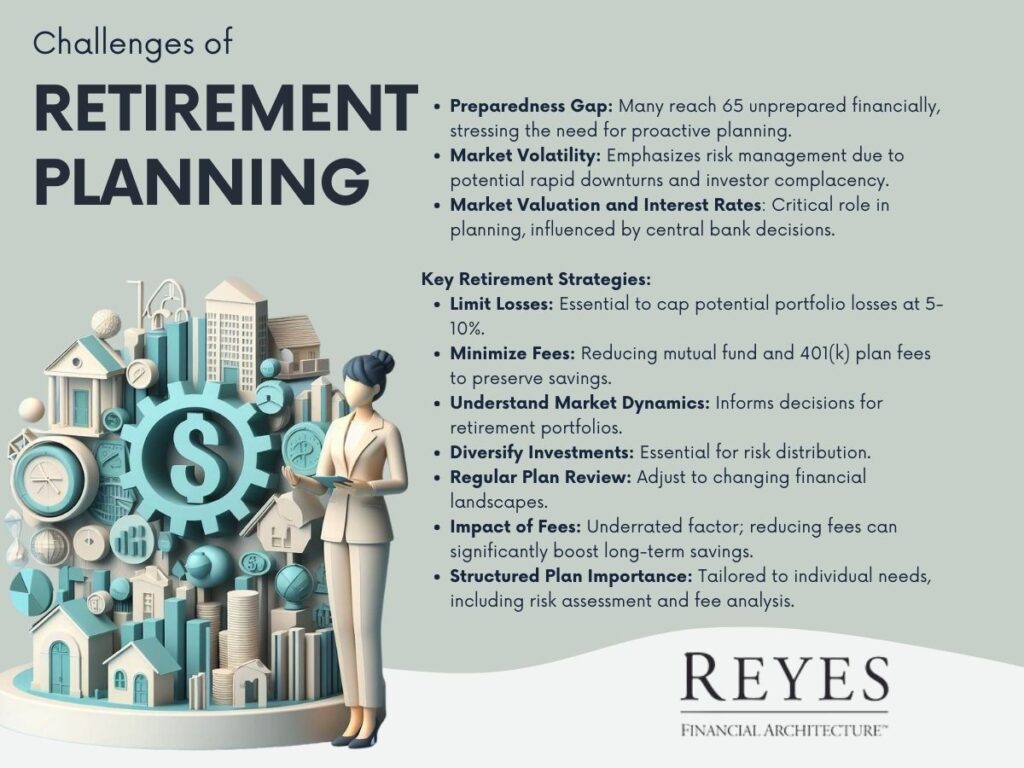
Statistics indicate a concerning trend: a large percentage of individuals reach the age of 65 without adequate financial resources, often relying on family or government support. This underscores the importance of proactive and strategic retirement planning, focusing on creating a guaranteed lifetime income.
Market volatility is a significant factor in retirement planning. Historical trends show substantial market downturns can occur rapidly, highlighting the need for a risk-aware investment approach. As time passes since major financial crises, there's a risk of investor complacency. Acknowledging and planning for potential market fluctuations is crucial in safeguarding retirement funds.
The valuation of the market, often influenced by decisions made by central banks like the Federal Reserve, especially regarding interest rates, plays a critical role in retirement planning. Overvaluation of the market and fluctuating earnings projections can impact investment strategies. Recognizing these factors can aid in making informed decisions for retirement portfolios.
To achieve a secure retirement, certain strategies and principles should be considered:
Additional strategies include understanding market dynamics, diversifying investments, and regularly reviewing and adjusting financial plans.
One often overlooked aspect of retirement planning is the impact of fees on long-term savings. Many individuals are unaware of the fees they incur, especially in investment products like mutual funds and employer-sponsored plans such as 401(k)s. Reducing these fees can lead to significant savings over time.
A structured retirement plan is critical. It should include a thorough risk assessment, an analysis of fees, and a comprehensive strategy tailored to individual needs and goals. A well-constructed plan provides clarity and a roadmap for achieving retirement objectives.
Effective retirement planning requires a multifaceted approach, balancing risk management, financial efficiency, and a deep understanding of market conditions. By adopting key strategies and maintaining a focus on long-term goals, individuals can enhance their chances of a financially secure retirement.
The process involves regular review and adaptation to changing circumstances, ensuring that retirement funds are not only accumulated but also protected and optimized for the long haul.
Planning for retirement requires a keen understanding of market trends, interest rates, and other economic indicators. Here, we explore strategies and insights for securing a financially stable retirement, even in the face of potential economic downturns.
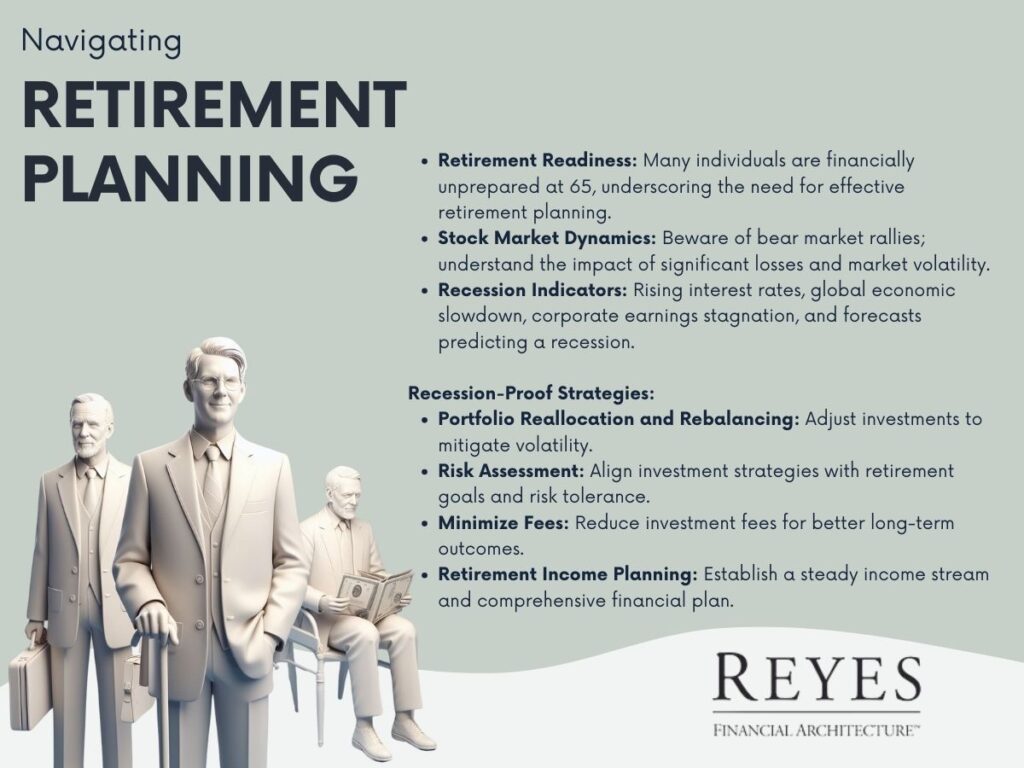
A significant number of individuals reach the age of 65 unprepared financially, often relying on family support or government assistance. This highlights the critical need for effective financial planning to ensure a consistent income throughout retirement.
An important aspect of stock market behavior to recognize is the phenomenon of bear market rallies. These are substantial yet typically temporary recoveries in a declining market, which can mislead investors into believing in the market's stability. The mathematical reality is that a stock falling by 50% and then gaining 50% is still 25% below its original value. This underscores the need to be wary of significant losses and to approach investment decisions with caution.
Several indicators suggest the possibility of an economic recession:
To reduce risks associated with economic downturns, several proactive measures are recommended:
Having a solid retirement plan can provide confidence, even during market downturns, preventing panic and impulsive decision-making.
The complexities of retirement planning, especially in uncertain economic times, make professional advice invaluable. Tailored retirement strategies, responsive to individual needs and economic conditions, are critical for achieving financial security in retirement.
Achieving a secure retirement amidst economic uncertainties is challenging but attainable with the right approach. Being informed about market dynamics, recognizing economic indicators, and taking strategic actions to protect retirement funds are integral to successful retirement planning. These insights offer guidance for individuals seeking to build a resilient and secure retirement plan, regardless of economic fluctuations.
https://youtu.be/tYioyLxbNTI
Take a minute to watch this video for important information on long-term care, a topic everyone needs to be ahead of.
Long-term care (LTC) is a critical aspect of health and personal care that affects a significant portion of the population. Statistics indicate a high probability—around 70%—that an individual or their spouse will require long-term care at some point. This statistic underscores the importance of understanding what long-term care entails, its costs, and how to prepare for it.
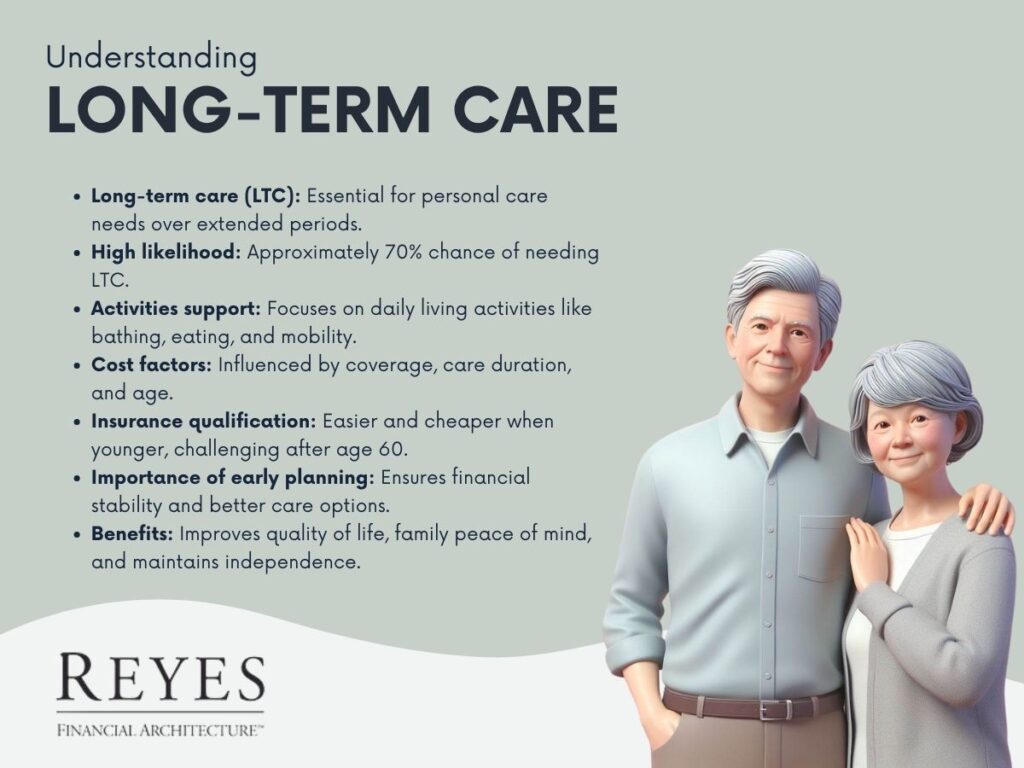
Long-term care refers to a variety of services and supports tailored to meet an individual’s personal care needs over an extended period. Contrary to common misconceptions, most long-term care is not medical in nature. Instead, it predominantly involves assistance with everyday activities crucial for daily living.
Activities of Daily Living, or ADLs, are fundamental tasks that most people perform daily without assistance. These include:
Instrumental Activities of Daily Living, or IADLs, are tasks that are somewhat more complex than ADLs and are essential for independent living. These include:
The cost of long-term care can vary significantly based on several factors:
The initial premium level for long-term care insurance tends to increase with the age of the applicant. Younger individuals typically face lower premiums, highlighting the advantage of planning for long-term care early.
Qualifying for long-term care insurance becomes more challenging with age. Statistics show that 1 in 4 applicants between the ages of 60 and 69 do not qualify for such insurance. This statistic is a stark reminder of the importance of early planning.
Given the high likelihood of needing long-term care and the associated challenges and costs, it is crucial to understand the options and prepare adequately. This preparation is not just a personal matter but also a significant consideration for families.
Understanding and preparing for long-term care is a critical aspect of life planning. Given the high probability of needing such care, it’s prudent to start planning early. This includes understanding what long-term care entails, evaluating insurance options, and considering personal and family needs. By taking proactive steps today, individuals can ensure they have the support and resources they need to maintain their quality of life and independence in the future.
Picture a scenario where you have a reliable pension plan that ensures a steady stream of income for both you and your spouse throughout your lifetimes. While this may seem like an enticing prospect, traditional pension plans often come up short in delivering such comprehensive financial benefits.
In this article, we will explore the concept of the perfect annuity, a financial instrument that combines the reliability of a pension with safeguards against inflation, offering a practical solution for those aiming for a secure retirement.
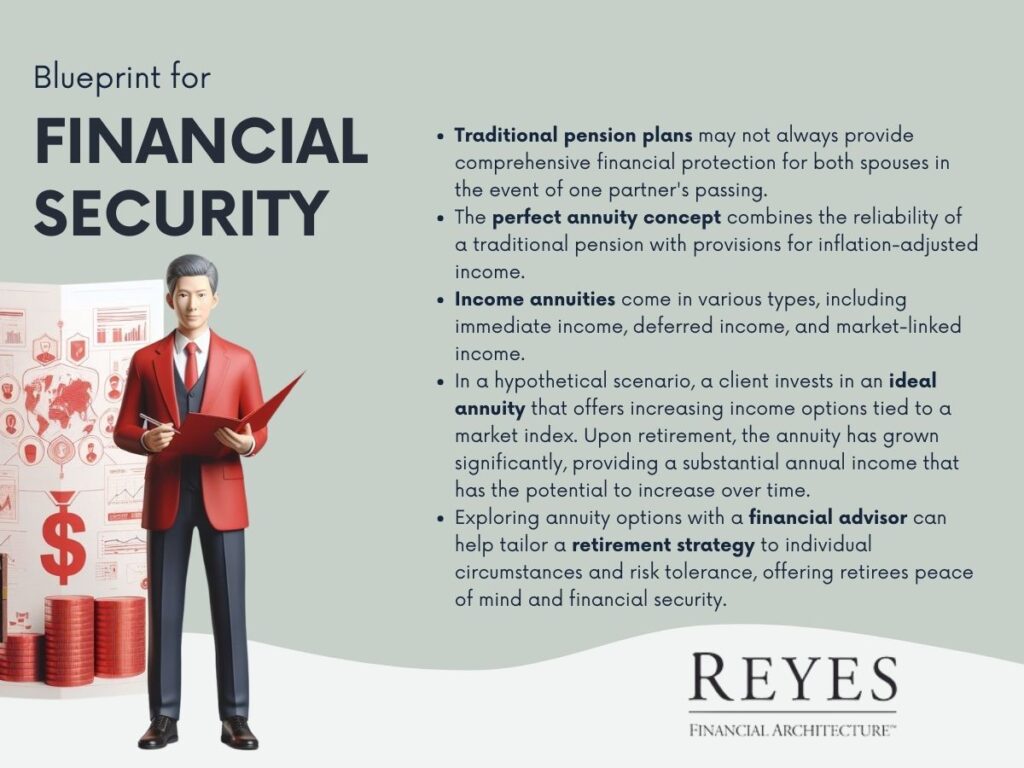
Conventional pension plans, although valuable, do not always guarantee equal income protection for both spouses in the unfortunate event of one's passing. Typically, the surviving spouse receives reduced or no pension income when one partner passes away.
Given that, statistically, husbands tend to predecease their wives, this discrepancy leaves the surviving spouse financially vulnerable. It underscores the need for an alternative financial solution that ensures guaranteed income for both individuals throughout their lifetimes.
The perfect annuity concept, which we will explore further, combines the strengths of a traditional pension with provisions for inflation-adjusted income. While it's essential to acknowledge that no financial product is entirely devoid of risks, we will provide a hypothetical example to illustrate the potential advantages of this concept.
Before delving into the hypothetical scenario, it's vital to understand the broad categories of income annuities:
Now, let's consider a scenario where a client invests a substantial sum in an ideal annuity that offers increasing income options tied to a market index. The client decides to defer their annuity for a specific period, aiming to retire at a later date.
Upon reaching retirement age, the annuity has grown significantly in value. The client can then choose to withdraw a percentage of the annuity value, resulting in a substantial annual income. This income represents a significant percentage of the original investment, providing financial security throughout their lifetime. Furthermore, this income has the potential to increase over time, providing protection against the erosive effects of inflation.
While the perfect annuity concept discussed in this article serves as a hypothetical example, it illustrates the potential benefits of merging the dependability of a traditional pension with provisions for income growth to counteract inflation. Such financial tools can offer retirees peace of mind, knowing they will receive a consistent income stream throughout their retirement years, with the added benefit of potential income growth.
It's essential to consult with a financial advisor to explore annuity options and tailor them to individual circumstances and risk tolerance. While the ideal annuity may not be suitable for everyone, it remains an intriguing concept for those seeking to secure their financial future and enjoy a retirement free from financial worries.